World-standard FWD compact coupe
Akinori Nakanishi
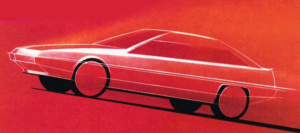
Image sketch
―― Overview
Around 1979, developing FWD models in the class above the Mirage was a major global trend. The Cordia, together with the Tredia sedan, was developed as a world-standard FWD compact coupe in its class, in a short schedule, with design work starting in July 1979 and the car being unveiled and launched in February 1982. In my second year in the design section, I was fortunate to be able to take charge of the exterior design of Cordia, a world car, at the age of 25. I worked on concept creation, sketch competition, and even 1/1 tape drawing and clay modeling, though just for the front of the body, all of which was my first experience. The experience I gained from this project was utilized in the many later projects I dealt with. Although domestic sales of Cordia did not grow as much as expected, in the global market, it received satisfactory sales as a 2-door coupe.
―― Concept making Camp
In July 1979, the exterior and interior design members held a four-day camp in Izu, Japan, in order to decide on a design concept early and share it with the team since the development schedule was very short. The participating members were Takio Nakagawa, chief designer, Shinichi Kobayashi, Masaru Furukawa, Shigehisa Ishii, Eizo Ohura, and Eiichi Ookuma and myself. I had imagined a friendly meeting as a camp, but I remember being surprised by the more heated discussions than I had expected. Regardless of rank within the company, candid discussions were exchanged. I guess this kind of discussion may have been possible just because the camp was held outside the company.
As a result of the camp, it was confirmed and shared among the members that the Tredia and Cordia would be cars for the global market, Japan, the U.S., and Europe, and that the styling theme should be pure styling without any pretense. The design of Mitsubishi cars at that time was basically functional and simple, similar to European cars, so the styling direction was shared among the members without any difficulty. However, even though I participated in the discussions with the senior members at the camp, I only understood the superficial meaning of the concept and was not able to organize it in my mind to the point where I could incorporate it into the design. This was exposed at the next sketch competition.
―― Sketch Competition
Based on the concept agreed upon at the camp, the teams were divided into sedan and coupe teams and started sketching at the Okazaki studio. The sedan team consisted of Nakagawa, Kobayashi, Ishii, Okuma, and the coupe team consisted of Shinji Yokoyama, Chief designer, Tatsuhiko Kuwahara, all of whom had not attended the camp, and myself.
I remember how unhappy I was when one of my seniors pointed out that my sketches looked like a collection of designs of European sporty coupes that often appeared in design magazines and concept cars of famous Italian designers. It was true that my sketches were less clear in design themes than the sketches that were selected for production, and my sketches did not clearly realize the concept.
After the sketches were completed, they were reviewed at an executive committee meeting attended by then Chairman Tomio Kubo, and the proposals of Nakagawa for the sedan and Yokoyama for the coupe were selected. Yokoyama’s sketch clearly expressed the concept of a simple front and concealed wheel arches, and these themes were directly applied to the production model.
The design elements in the selected sketch were clearly connected to the concept and had characteristics that could be explained in simple words. I realized my inexperience in the sketch stage, but the next 1/1 stage, was even more difficult.
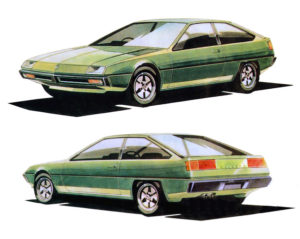
Selected proposal sketch by Shinji Yokoyama
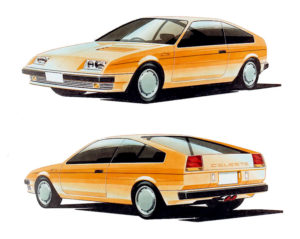
Proposal sketch by Tatsuhiko Kuwahara
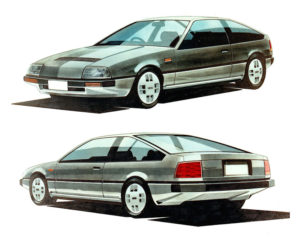
Proposal sketch by writer
―― 1/1 tape drawing and clay model making
Masaru Furukawa, who did not participate in the sketch stage, participated from the 1/1 planning stage, and was in charge of the overall exterior design, Kuwahara worked on the rear area, and I worked on the front area. While keeping the image of the selected sketch by Yokoyama, 1/1 tape drawing was done on the basic package drawing, and based on this, a 1/1 drawing for the clay model was prepared. Since it was supposed to be a global standerd car, aerodynamic performance was an important element in the design. Therefore such elements were incorporated into the simple front and sharp body of the sketch, and the front and rear of the body were tapered in plan view that create a three-dimensional image. The concealed rear wheel cuts that characterize the side view were also part of the aerodynamic treatment, and were realized as shown in the sketch to prevent airflow from being drawn in by the wheels. The reported Cd were 0.39 for the Tredia and 0.34 for the Cordia, which were quite excellent for the time.
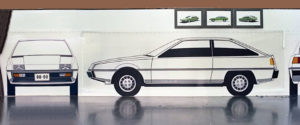
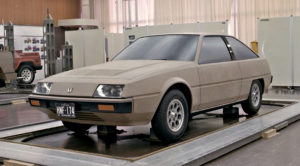

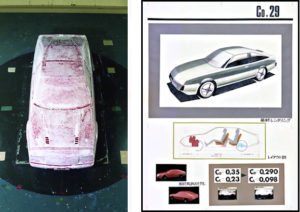
Wind tunnel test model (left) Panel summarizing wind tunnel test results (right)
As the design was being refined for the production, it was decided that the headlights would be shared with those of the sedan, resulting in a slightly more sculpted and three-dimensional image compared to the flashy image of the sketch. The clean and sharp image of the original design was somewhat diminished. This was a lesson for me that it was necessary to consider the profitability of a car model with a small number of units planned. Even though it was the front half, it was my valuable first experience with 1/1 tape drawing and body drawing. In particular, I learned that body design cannot be judged without looking at it from a distance. Also, I had a hard time when I decided on a shape only with a drawing and found odd areas when it came to the three-dimensional body.
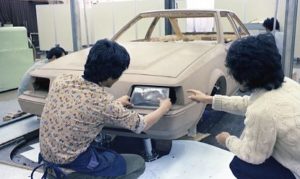
Ryoji Miura (left) and writer (right) studying possibility of sharing headlights with Tredia
For example, the plan view of the front part of the Cordia was fairly tapered, so when the groove in the center of the side view was made horizontal in the drawing, it appeared to rise up to the front when viewed from diagonally above. This line was corrected many times, on the model, so that it would not appear to rise up to the front, and this was reflected in the drawing as a visual adjustment. This correction was due to my inexperience.
Thanks to the patience and support of the veteran modeler, I was able to reflect the proper visual corrections in the drawings. As a result, the groove in the center of the side view of the Cordia is not horizontal but slightly sloped down to the front.
Although I felt pressure to work with experienced senior designers and veteran modelers, I was able to finish the 1/1 model with their strict but warm support and advice. In particular, the modeler Ryouji Miura helped me a lot. The experience I gained from this project was very useful on another project from 1980, after the completion of Cordia project, where I drew drawings for a whole car and worked on a 1/1 model.

―― Launching
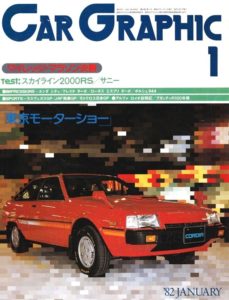
Cover of CAR GRAPHIC January 1982 issue
The Cordia prototype was exhibited as a reference exhibit at the 24th Tokyo Motor Show in the fall of 1981 and was featured on the cover of the January 1982 issue of CAR GRAPHIC magazine. I was told by a senior colleague that it was very rare for a Mitsubishi cars to be featured on the cover of CAR GRAPHIC. When I read the article, I was pleased to find favorable comments about the front tapering that I had struggled with. In February 1982, the following year, the Cordia XP for Plaza channel and the Cordia XG for Galant channel were launched together with the Tredia sedan.
The Cordia’s PR illustrations were drawn by Shusei Nagaoka, a popular illustrator at the time, for the PR of the Cordia. He commented on it, “’A space coupe from 2001’, which was my first impression of Cordia when I saw the styling, roominess with a sense of space. It is exactly the car that fits my image. “
The Cordia was expected to be a new generation of world car, and was introduced to the market with advertising campaigns such as exhibiting at motor shows and using a famous illustrator, but domestic sales in 1982 only managed to exceed 20,000 units, and in 1983 sales fell below 10,000 units. Production was finished in 1987, but the total domestic sales volume remained at about 33,000 units.
On the other hand, as a world car, which was the original goal, Cordia was well received with it’s design, in the United States, Australia, New Zealand, and South Africa, and sales grew, with 122,705 units produced over the Cordia’s lifetime, an excellent result for a Mitsubishi two-door coupe.
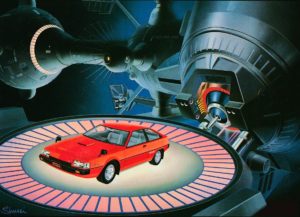
Illustration by Shusei Nagaoka
After the launch of Cordia in 1982, I made a long-term business trip to North America to establish a California studio with Masaru Furukawa. At this time, I was able to witness the survey for the launch of Cordia in North America. The Cordia was evaluated side by side with competing models in Japan and the U.S., and the styling evaluation result was the highest among the competitors. However, the other competing cars were already on the market in 1982 and lacked freshness, and the Cordia was not enthusiastically supported. I remember one of the survey respondents commenting “Good but too much typical”. If there had been a strong appeal to make people want to buy this car, it might have increased sales even in the sluggish domestic market. Looking back, I believe that this point should be reflected upon.
The Cordia was the first project in which I participated in a concept camp, sketch competition, and worked on a partial but 1/1 model. The experience I gained from this project, the connections I made with the people I worked with, and my reflections on the project became a great asset for the development of subsequent projects.
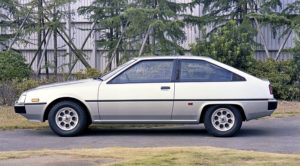
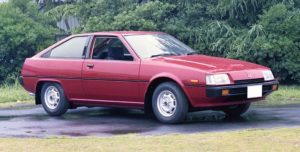
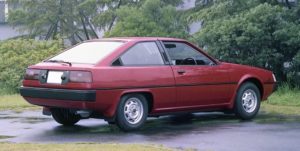
September 2021